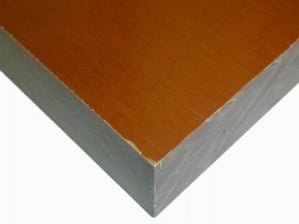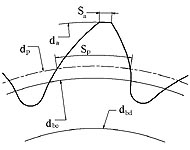stephen thomas
Diamond
- Joined
- Jun 3, 2001
PEI, then, maybe?
Should be stronger than delrin & phenolic.
Less intrinsic lubricity than PEEK, though.
Should be stronger than delrin & phenolic.
Less intrinsic lubricity than PEEK, though.
Follow along with the video below to see how to install our site as a web app on your home screen.
Note: This feature may not be available in some browsers.
Easier and more relable to just make them out of phenolic. You know it works.PEI, then, maybe?

last time I bought a 6" long 3" diameter PEEK bar I paid 400 bucks for it from McMaster.
 ) pretty sure there are cheaper options than Mc Master. OTOH, you are correct that it won't be _cheap_ anywhere.
) pretty sure there are cheaper options than Mc Master. OTOH, you are correct that it won't be _cheap_ anywhere.Easier and more relable to just make them out of phenolic. You know it works.
Its not cheap ...I have a sheet of phenolic 3ft x 2ft x 1/2 " ,that cost over $1000........it was bought to make vanes for compressors. .........and I might add ,that price was 30 years ago.


Grain goes the wrong wayLignum vitae. I've got a stash that came out of the navy yard. Self lubrication and used in ship bearings.


I'm trying to offload my stash at an exorbitant price.Grain goes the wrong way
Possibly try bronze tho. It's worth a shot as a test. OP needs a test stand
Some pieces I'm looking at pushing towards the printer are gears. Currently we machine some specialized gears from grey iron, mild steel, 4140 and A2, and we purchase more generic gears from the usual sources. There's a few specialized gears we sub out to be made from Phenolic, and prices on those gears has been going up prohibitively. What I'm wondering is if we made a gear from 3D printed Kevlar fiber or carbon fiber (I've been looking at Markforged machines), could we expect the same strength and wear qualities as the phenolic gears of the same dimensions? Or does it really depend on the tooth cross sections, maintained and momentary load, etc.?
These phenolic gears are in open lubricated environments running 500rpm or less. I don't think I've ever seen one worn out, but periodically teeth get broken, so we do sell them as replacements in addition to new builds. With a couple exceptions, most are a long tooth design for variable pitch diameter, and were steel 70+ years ago. Phenolic has been an improvement in the wear properties and operating noise level, but it's not getting any cheaper in the quantities we need. Some of the other tool steel and mild steel gears are also candidates for 3D printing in an effort to decrease noise and improve wear properties, but they are higher load bearing so I'm expecting we would have to do some R&D to see if 3D printings would hold up. I'm curious about the Phenolic replacement though as it could potentially pay for the machine investment, while the steel replacement may or may not pan out.
So in short: What if any 3D printing material is a drop in replacement for Phenolic Resin Gears?
Again, while making gears on a 4th axis isn't the fastest, it works well for our small batchs. Someday we can get into better conventional methods of making gears, but that's not the problem today qnd not the point of this thread.
Thanks for the insight. I appreciate everyone's patience and hope I'm not adding confusion with the general nature of the query looking at multiple parts.And ...
With apologies to the OP and his query. The posts that I intermittently responded to seem to have been the result of the typical topic drift and did not help his original query. Thanks to DGFoster for bringing it up to me.
After going back and reading the thread, I did not see any power requirements. Only RPM. Power, Pitch, Tooth Counts, and Face Width would be helpful. Especially in regard to available envelope for Face Width variation toward thicker. Does the mechanism rotate in both directions? Or only ever one?
I ask because if only ever one, and breakage is the most common form of failure ( over wear ), then you might just want to consider an Asymmetric Tooth Form. Not overly common, but not uncommon, and a fantastic way to combat the issues of Strength and Noise, from a gear design standpoint. Also, what kind of breakage? Is it breaking in the Root? Would Root Optimization prevent it? We won't know until more details are available...
If you are limiting to only standard Tooth Forms, then depending on power/strength needs and available Face Width variation, I'd say the recommendations of Phenolic, PEEK, and GFN are all very valid. I would personally stay as far away from 3D printing for a *TON* of reasons, all of which I have written repeatedly about on this and other forums. Between the design side (CAD) and the execution side, they just simply suck. ( that's a technical term ) ESPECIALLY, if you are considering a long tooth variation.
I've machined ( Tooth Space/Form Milled ) and generated ( Hobbed/Shaped ) gears in all three materials, and molded them in both GFN and PEEK. There are pictures of many of them upon our social medias and website, but I'm too busy ( and lazy ) to dig them out specifically. ( it's a lot of pictures to go through ) There is no way to say with any real certainty which will be best for you, without knowing the things that I pointed out, in the beginning of my reply. However, if you can fill in the blanks we can likely get you pointed in the right direction. From the WAG department, I'd wager that any of the three would likely work, and some attention to the actual design side might make them lifelong service. I'd probably try Phenolic first because it's easy, but if there are serious concerns, I'm guessing that cut PEEK gears should be positively fine. Can't really say with any more certainty or numbers without knowing the work envelope and details. Also, you may want to reach out to some other gear making facilities and just simply ask the question, "Can you make this for less than $X.XX?" You might just find that you are making a ton of work for yourself where you do not need to. Dan, EmGo, Peter, and several others gear folk ( as well as myself ) tend to naturally *want* to help someone when they need it.
Can they have a 1.0" Face Width? 1.25"? What is possible? Also, this sounds like a great opportunity for Asymmetrical Tooth Forms. Think helicopter rotor gear boxes... It's not necessary, as I think we can likely figure out a solution for you, but I would definitely remain open to considering it as a very possible solution.Thanks for the insight. I appreciate everyone's patience and hope I'm not adding confusion with the general nature of the query looking at multiple parts.
I'll need to get more of the details, but the phenolic gears are between 5/8 and 3/4 wide. I don’t have data on the specific forces they are seeing, as they were engineered long before my time and all we have are the dimensions, not the data that lead to those dimensions, though I can tell you they are powered by 1/2 to 1 HP motors, and that the motor RPM is reduced via pulleys and gears, and that will of course generate additional torque.
Most of the phenolic gears I've seen fail have been sheared teeth, and again that was due to operators miss using the machine more than a flaw in the gear design. Most of these gears operate in one direction, with reverse only being to back work out of the machine in the event of a problem, but the load on the gears is intermittent and can vary, so I think both sides of the gear profile will see load, but most of it would be on one side.
The steel helical gear that rings is about 1/4" wide, with approximately 45 degree tooth angle (will need to verify that). I've never seen one of those break.

Wider might be possible. There's room in the gearboxs, but I'll have to look at clearance with the surrounding parts.Can they have a 1.0" Face Width? 1.25"? What is possible? Also, this sounds like a great opportunity for Asymmetrical Tooth Forms. Think helicopter rotor gear boxes... It's not necessary, as I think we can likely figure out a solution for you, but I would definitely remain open to considering it as a very possible solution.

Also, have you ever considered simply attaching dampening material to the face of the metal gears? (assuming that there is room)
For the purpose of simplicity, you should be able to have a properly designed gear of otherwise typical form, though. I really do not see any reason that you shouldn't. This could really be as simple as a Face Width as wide as the envelope allows and an Optimized Root Trochoid Geometry to relieve stress risers.
For those others as self abusive as I am that have spare time and interest, more on Asymmetric Tooth Forms and their applications can be read about to some extent, here - Alex Kapelevich on Harnessing Direct Gear Design for asymmetric gears results in low weight-to-output torque ratio and reduced levels of noise and vibration
That's what I'm thinking. Specifically, if you determine that it *is* a Root Stress issue it's nearly certain that simply adding Face Width and optimizing the Root Trochoid will eliminate the issue as well as remain backwards compatible. ( with all other things being equal )Wider might be possible. There's room in the gearboxs, but I'll have to look at clearance with the surrounding parts.
With the phenolic gears, failure as they are currently made isn't really an issue. When they fail, it's typically just one gear and that's the only one replaced, so ideally we would want to make new gears that still assemble and mesh with old ones, though having a new design and stocking a few old style gears for support is a possibiliy too. The only reason I would want to improve the design is if having a better profile or wider gear would enable a slightly more inferior material to perform the same or better than the old way, using better material with a more inferior design.
Notice
This website or its third-party tools process personal data (e.g. browsing data or IP addresses) and use cookies or other identifiers, which are necessary for its functioning and required to achieve the purposes illustrated in the cookie policy. To learn more, please refer to the cookie policy. In case of sale of your personal information, you may opt out by sending us an email via our Contact Us page. To find out more about the categories of personal information collected and the purposes for which such information will be used, please refer to our privacy policy. You accept the use of cookies or other identifiers by closing or dismissing this notice, by scrolling this page, by clicking a link or button or by continuing to browse otherwise.
